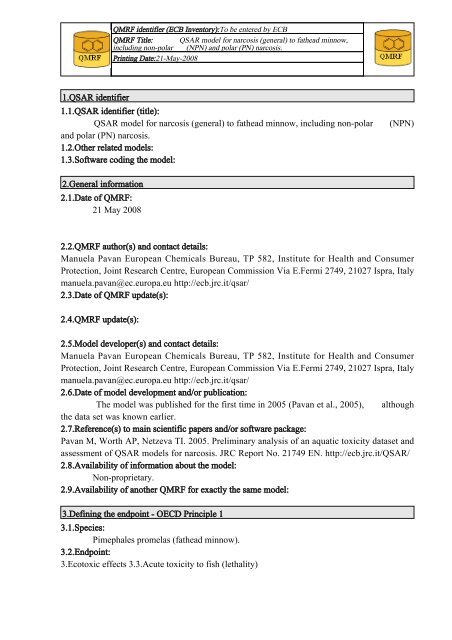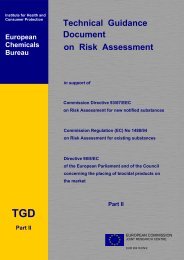QSAR model for narcosis (general) to fathead minnow, including ...
QSAR model for narcosis (general) to fathead minnow, including ...
QSAR model for narcosis (general) to fathead minnow, including ...
You also want an ePaper? Increase the reach of your titles
YUMPU automatically turns print PDFs into web optimized ePapers that Google loves.
1.<strong>QSAR</strong> identifier<br />
1.1.<strong>QSAR</strong> identifier (title):<br />
<strong>QSAR</strong> <strong>model</strong> <strong>for</strong> <strong>narcosis</strong> (<strong>general</strong>) <strong>to</strong> <strong>fathead</strong> <strong>minnow</strong>, <strong>including</strong> non-polar (NPN)<br />
and polar (PN) <strong>narcosis</strong>.<br />
1.2.Other related <strong>model</strong>s:<br />
1.3.Software coding the <strong>model</strong>:<br />
2.General in<strong>for</strong>mation<br />
2.1.Date of QMRF:<br />
21 May 2008<br />
2.2.QMRF author(s) and contact details:<br />
Manuela Pavan European Chemicals Bureau, TP 582, Institute <strong>for</strong> Health and Consumer<br />
Protection, Joint Research Centre, European Commission Via E.Fermi 2749, 21027 Ispra, Italy<br />
manuela.pavan@ec.europa.eu http://ecb.jrc.it/qsar/<br />
2.3.Date of QMRF update(s):<br />
2.4.QMRF update(s):<br />
QMRF identifier (ECB Inven<strong>to</strong>ry):To be entered by ECB<br />
QMRF Title: <strong>QSAR</strong> <strong>model</strong> <strong>for</strong> <strong>narcosis</strong> (<strong>general</strong>) <strong>to</strong> <strong>fathead</strong> <strong>minnow</strong>,<br />
<strong>including</strong> non-polar (NPN) and polar (PN) <strong>narcosis</strong>.<br />
Printing Date:21-May-2008<br />
2.5.Model developer(s) and contact details:<br />
Manuela Pavan European Chemicals Bureau, TP 582, Institute <strong>for</strong> Health and Consumer<br />
Protection, Joint Research Centre, European Commission Via E.Fermi 2749, 21027 Ispra, Italy<br />
manuela.pavan@ec.europa.eu http://ecb.jrc.it/qsar/<br />
2.6.Date of <strong>model</strong> development and/or publication:<br />
The <strong>model</strong> was published <strong>for</strong> the first time in 2005 (Pavan et al., 2005), although<br />
the data set was known earlier.<br />
2.7.Reference(s) <strong>to</strong> main scientific papers and/or software package:<br />
Pavan M, Worth AP, Netzeva TI. 2005. Preliminary analysis of an aquatic <strong>to</strong>xicity dataset and<br />
assessment of <strong>QSAR</strong> <strong>model</strong>s <strong>for</strong> <strong>narcosis</strong>. JRC Report No. 21749 EN. http://ecb.jrc.it/<strong>QSAR</strong>/<br />
2.8.Availability of in<strong>for</strong>mation about the <strong>model</strong>:<br />
Non-proprietary.<br />
2.9.Availability of another QMRF <strong>for</strong> exactly the same <strong>model</strong>:<br />
3.Defining the endpoint - OECD Principle 1<br />
3.1.Species:<br />
Pimephales promelas (<strong>fathead</strong> <strong>minnow</strong>).<br />
3.2.Endpoint:<br />
3.Eco<strong>to</strong>xic effects 3.3.Acute <strong>to</strong>xicity <strong>to</strong> fish (lethality)
3.3.Comment on endpoint:<br />
LC50 - the concentration causing 50% lethality in Pimephales promelas, after an<br />
exposure of 96 hours.<br />
3.4.Endpoint units:<br />
Moles per liter.<br />
3.5.Dependent variable:<br />
log LC50<br />
3.6.Experimental pro<strong>to</strong>col:<br />
See: Veith et al. (1983) and Verhaar et al. (1995).<br />
3.7.Endpoint data quality and variability:<br />
4.Defining the algorithm - OECD Principle 2<br />
4.1.Type of <strong>model</strong>:<br />
Regression-based <strong>QSAR</strong>.<br />
4.2.Explicit algorithm:<br />
Linear regression <strong>QSAR</strong>.<br />
<strong>QSAR</strong> <strong>model</strong> based on one single descrip<strong>to</strong>r.<br />
Log LC50 = -0.810 LogKow - 1.74<br />
4.3.Descrip<strong>to</strong>rs in the <strong>model</strong>:<br />
Log Kow The descrip<strong>to</strong>r (log Kow) data are both experimental and calculated values. Even if<br />
Kow is usually considered a good physicochemical descrip<strong>to</strong>r, there is no evidence that the<br />
measurements were made by the same pro<strong>to</strong>col, in the same labora<strong>to</strong>ry. Thus a certain amount<br />
of variability could be present.<br />
4.4.Descrip<strong>to</strong>r selection:<br />
4.5.Algorithm and descrip<strong>to</strong>r generation:<br />
4.6.Software name and version <strong>for</strong> descrip<strong>to</strong>r generation:<br />
4.7.Descrip<strong>to</strong>rs/Chemicals ratio:<br />
5.Defining the applicability domain - OECD Principle 3<br />
5.1.Description of the applicability domain of the <strong>model</strong>:<br />
The <strong>QSAR</strong> <strong>model</strong> was defined by the developer <strong>to</strong> be applicable <strong>to</strong> chemicals with<br />
logKow values in range from -1.31 <strong>to</strong> 6.20. HOWEVER, the <strong>model</strong> is not reccomended <strong>for</strong><br />
chemicals with logKow < 1 due <strong>to</strong> large error <strong>for</strong> both non-polar and polar narcotics. It<br />
works best in the range 3 < logKow < 6. The <strong>model</strong> can be suitable <strong>for</strong> chemicals acting by<br />
<strong>narcosis</strong> mode of action, and it is recomended only when the precise mechanism (i.e. nonpolar<br />
or polar <strong>narcosis</strong>) is difficult <strong>to</strong> be determined. The structural domain includes aliphatic<br />
and aromatic hydrocarbons, halogenated aliphatic and aromatic hydrocarbons, ethers,<br />
alcohols, aromatic nitrocompounds, anilines and phenoles (only when a presence of an<br />
additional subtiuent on the benzene ring in case of phenols and anilines do not change the<br />
mechanism of action).<br />
5.2.Method used <strong>to</strong> assess the applicability domain:<br />
Expert judgement<br />
5.3.Software name and version <strong>for</strong> applicability domain assessment:<br />
5.4.Limits of applicability:
See 5.1<br />
6.Internal validation - OECD Principle 4<br />
6.1.Availability of the training set:<br />
Yes<br />
6.2.Available in<strong>for</strong>mation <strong>for</strong> the training set:<br />
CAS RN:Yes<br />
Chemical Name:Yes<br />
Smiles:Yes<br />
Formula:No<br />
INChI:No<br />
MOL file:No<br />
6.3.Data <strong>for</strong> each descrip<strong>to</strong>r variable <strong>for</strong> the training set:<br />
All<br />
6.4.Data <strong>for</strong> the dependent variable <strong>for</strong> the training set:<br />
All<br />
6.5.Other in<strong>for</strong>mation about the training set:<br />
6.6.Pre-processing of data be<strong>for</strong>e <strong>model</strong>ling:<br />
6.7.Statistics <strong>for</strong> goodness-of-fit:<br />
The <strong>model</strong> has been trained by 144 chemicals.<br />
Predic<strong>to</strong>r=Constant Coeff.= -1.74 SE=0.070;<br />
Predic<strong>to</strong>r=LogKow Coeff.=-0.810 SE=0.026;<br />
The following fitness regression parameters were calculated <strong>for</strong> this <strong>QSAR</strong>:<br />
R2 = 87.55 (Coefficient of determination);<br />
R2adj = 87.46 (Coefficient of determination adjusted <strong>for</strong> the degrees of freedom);<br />
s = 0.455 (Standard error of the estimate);<br />
F = 998.3 (Fisher function);<br />
LOF = 0.21 (Friedman modified);<br />
SDEC = 0.452 (Standard Deviation Error in Calculation);<br />
AIC = 0.213 (Akaike In<strong>for</strong>mation Criterion);<br />
FIT = 6.83 (Kubinyi function).<br />
6.8.Robustness - Statistics obtained by leave-one-out cross-validation:<br />
The <strong>model</strong> was evaluated by leave-one-out internal cross-validation ( Q2LOO ).<br />
Q2LOO = 87.06 (explained variance in prediction);<br />
6.9.Robustness - Statistics obtained by leave-many-out cross-validation:<br />
6.10.Robustness - Statistics obtained by Y-scrambling:<br />
6.11.Robustness - Statistics obtained by bootstrap:<br />
The <strong>model</strong> was evaluated bootstrap with 5000 iterations.<br />
Q2bootstrap = 87.11 (explained variance in prediction by bootstrapping);<br />
6.12.Robustness - Statistics obtained by other methods:<br />
SDEP = 0.461 (Standard Deviation Error in Prediction).
7.External validation - OECD Principle 4<br />
7.1.Availability of the external validation set:<br />
Yes<br />
7.2.Available in<strong>for</strong>mation <strong>for</strong> the external validation set:<br />
CAS RN:Yes<br />
Chemical Name:Yes<br />
Smiles:Yes<br />
Formula:No<br />
INChI:No<br />
MOL file:No<br />
7.3.Data <strong>for</strong> each descrip<strong>to</strong>r variable <strong>for</strong> the external validation set:<br />
All<br />
7.4.Data <strong>for</strong> the dependent variable <strong>for</strong> the external validation set:<br />
All<br />
7.5.Other in<strong>for</strong>mation about the external validation set:<br />
7.6.Experimental design of test set:<br />
For external validation, subset of a list containing 177 OECD SIDS chemicals<br />
(ENV/JM/TG(2004)26) with measured LC50 values <strong>to</strong> <strong>fathead</strong> <strong>minnow</strong> was used. The<br />
chemicals in the test set are within the range of log Kow of the training set and classified as<br />
narcotics (either non-polar or polar) in a consensus meachnism of action classification.<br />
7.7.Predictivity - Statistics obtained by external validation:<br />
N. ext = 17<br />
Q2ext = 84.31<br />
SDEPext = 0.637<br />
The two nonyl phenols were excluded from these statistics due <strong>to</strong> high leverage.<br />
7.8.Predictivity - Assessment of the external validation set:<br />
7.9.Comments on the external validation of the <strong>model</strong>:<br />
8.Providing a mechanistic interpretation - OECD Principle 5<br />
8.1.Mechanistic basis of the <strong>model</strong>:<br />
The mechanistic interpretation <strong>for</strong> logKow is related <strong>to</strong> the partitioning of the<br />
substance from water in<strong>to</strong> the organisms lipid phase.<br />
8.2.A priori or a posteriori mechanistic interpretation:<br />
Context dependent on the alert.<br />
8.3.Other in<strong>for</strong>mation about the mechanistic interpretation:<br />
9.Miscellaneous in<strong>for</strong>mation<br />
9.1.Comments:<br />
Comment on the algorithm: n = 144 (combination of the training sets of the<br />
<strong>model</strong>s <strong>for</strong> non-polar <strong>narcosis</strong> and polar <strong>narcosis</strong> in EU TGD on risk assessment)<br />
9.2.Bibliography:<br />
[1]Veith, GD, Call, DJ and Brooke, LT. (1983). Structure-<strong>to</strong>xicity relationships <strong>for</strong> the <strong>fathead</strong><br />
<strong>minnow</strong>, Pimephales promelas: Narcotic industrial chemicals. Canadian Journal of Fisheries and<br />
Aquatic Sciences. 40, 743-748<br />
[2]Verhaar, H.J.M., Mulder, W. and Hermens, J.L.M. (1995). <strong>QSAR</strong>s <strong>for</strong> eco<strong>to</strong>xicity. In:
Overview of structure-activity relationships <strong>for</strong> environmental endpoints, Part 1: General outline<br />
and procedure. Hermens, J.L.M. (Ed), Report prepared within the framework of the project<br />
“<strong>QSAR</strong> <strong>for</strong> Prediction of Fate and Effects of Chemicals in the Environment”, an international<br />
project of the Environmenta; Technologies RTD Programme (DGXII/D-1) of the European<br />
Commission under contract number EV5V-CT92-0211<br />
9.3.Supporting in<strong>for</strong>mation:<br />
Training set(s)Test set(s)Supporting in<strong>for</strong>mation<br />
10.Summary (ECB Inven<strong>to</strong>ry)<br />
10.1.QMRF number:<br />
To be entered by ECB<br />
10.2.Publication date:<br />
To be entered by ECB<br />
10.3.Keywords:<br />
To be entered by ECB<br />
10.4.Comments:<br />
To be entered by ECB








